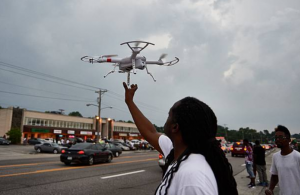(ThyBlackMan.com) Historically, cities grew up around a central district of commerce. People would move to the town and set up businesses in the center, close to major transport hubs. Residents of the surrounding suburbs would then flood to the middle, pushing up land values and creating a virtuous cycle of wealth creation.
The typical city structure that we see today is a direct product of this process in action. You have the urban core surrounded by a lower density periphery where developments can afford to spread out. It is the way that it has been done for hundreds of years, so it is hard to imagine how it might change.
Cities, however, only take this structure because of the need to make use of every available square inch of space in the middle. Companies build upwards to save on land rental costs. That’s why you never see vast warehouses in the center of town. It’s just not economical.
But the whole paradigm depends on the notion that the city center is at the confluence of the transport network. Road, rail, bus, taxi, and tram converge on a small plot of land, making it the most accessible point in the urban region. Everyone locates there because it is fundamentally easy to get there (even if your morning commute suggests otherwise)!
Drones, however, could fundamentally change that dynamic. And the result could be a radical rethinking of the way that humanity designs cities.
2D Versus 3D Transport
Elon Musk of SpaceX and Tesla fame talks about the difference between 2D transport and its more advanced, 3D counterpart. 
Currently, our cities have a problem. Tall buildings have made them three-dimensional, and yet the transport systems connecting them are fundamentally two-dimensional. Double-decker roads do exist, but they’re the exception, not the norm.
Musk points out that this is a mistake. The reason our cities are so congested is that we have three-dimensional buildings and a two-dimensional transport system. This setup creates all kinds of bottlenecks and traffic jams. Musk envisions a world in which the transport network uses the “z-direction” too, solving all our problems.
Of course, all this thought closely relates to the Boring company – a Musk spin-off he hopes will eventually create a lattice of underground tunnels under cities, providing quick transport from the suburbs to the CBD. People will be able to travel through layer upon layer of shafts, shuttling underneath street traffic in just a fraction of the time it currently takes, all while sitting in their regular motor vehicles.
Musk’s idea is interesting, but that isn’t the point. The fundamental principle here is that if you want to solve the traffic problem forever, you have to make transport three-dimensional, using all available volume.
And here’s where drones could potentially provide a game-changing role. You can stack drones up to the top of the sky, so to speak. There’s an enormous volume of space waiting there, just above our heads, for them to exploit. People could hop into a drone and essentially fly along a sky highway until they reach their destination. If one of these fills up, then the onboard software could open another one in the space above it. Nobody would ever get stuck in a jam on the way to work ever again.
The Benefits Of A Drone Transport Infrastructure
The long term benefits of this type of transport system could be significant. The first thing that it would do is remove the continual battle commuters face trying to get anywhere during the morning and evening rush hour. So long as you had enough drones, you could ferry everyone home from work through the airspace above a city without any of that stress or wasted time. It’ll be a bit like traveling to the office on a gondola.
The next benefit would be to reduce emissions. Scientists currently worry that the diesel and gasoline fumes cause a host of diseases, like COPD and cancer. Many are now lobbying the government to impose restrictions on the use of these kinds of vehicles. Drones, however, run entirely on lithium-ion batteries, and so they don’t produce any air pollution directly.
Drones could potentially save city authorities massive amounts of money and allow them to reduce taxes. Transport infrastructure is not cheap to maintain. And it certainly isn’t inexpensive to flesh out across an already-developed city. You have to demolish and reroute constantly. It costs a fortune. Drones, however, could help to take the strain off the public finances by eliminating the need for massive investment projects like these. So long as drones have space to land and take off, they can replace complex transport infrastructures in a single stroke.
If public authorities are worried about how tourists and the poor can access city centers, they can run their own drone services or open up the roads to bicycles. The possibilities are quite remarkable when you think about full-scale implementation.
Smaller Drones Will Have An Impact Too
It’s not just megaprojects, like replacing the motor vehicle fleet with drones, that could impact cities. Smaller consumer products, like the Mavic Air 2, could radically alter how they operate too.
Drones are essentially eyes in the sky – robots that provide you with a remote bird-eye view feed of your surroundings. These devices, therefore, could change how certain services work.
Take traffic wardens, for instance. With drones, you wouldn’t need to have people in uniforms wandering around parking lots, checking that people were displaying their tickets. Instead, you could have a bunch of people in an office, piloting drones via the web doing virtually the same job. Their cameras would feedback data that the wardens could then analyze.
Drones could also help with policing work. The police know that when groups congregate at certain times of the day, crimes are more likely. Right now, they have to dispatch an officer to the scene to prevent wrongdoing from taking place. But in the future, they could do something similar with a drone, a camera, and the ability to speak with people on the ground.
The nature of house building projects will change too. Properties with UAV landing zones will suddenly become more popular. Buyers will want homes that offer dedicated space to accept a drone.
The nature of access routes could change too. Currently, a large number of sectors of the economy rely on access tunnels and other infrastructure to facilitate inspections. Drones, though, could put an end to the need to make this kind of investment. Already, companies are using UAVs to inspect wind turbines, crops, and building progress.
The Business Opportunities That Drones Will Create
Drones are a sort of “platform technology,” a bit like the internet. There are opportunities for smart entrepreneurs to layer business models on top of them and make enormous profits.
The first crop of companies that emerge will be analogous to today’s mechanics. These specialists and technicians will troubleshoot and repair drones. They will also ensure that they meet minimum safety requirements.
Next will come the companies that create the technology that links drones to their users. What form this will take isn’t yet clear, though we can be quite confident that it will make heavy use of goggles and heads-up displays. There will be a great need for companies that can provide a reliable connection between the drone and the user.
As batteries continue to improve, the use cases of drones will expand. Before long, there will be passenger drones that can economically fly workers from one side of the city to another, or take them from the airport to where they need to be. And with this, ride-sharing firms will continue to expand their user base.
The exact scope of the opportunity is too large to imagine. Companies may use drones in search and rescue operations. We could see pizza delivery drones replacing Deliveroo. And we may see the emergence of drone sports, like drone racing, just as we did with the motor car.
Not all uses of drones, however, are futuristic. Many are already making a difference to cityscapes right now by helping to clear up clutter and unnecessarily sky furniture. And in the realm of agriculture, farmers are using them to check on crops without having to go out into the field themselves.
The Cons Of Passenger Drones
Of course, it’s not all good news. Drones come with some pretty significant drawbacks that we need to solve before they hit the mainstream.
The first and most obvious is the consequences of a mid-air collision. Unlike a regular shunt on the road, practically any crash in the air is catastrophic for those on board and puts everyone underneath at risk. We will need robust, autonomous systems in place to prevent this kind of event.
The second issue, of course, is the noise. Thousands of drone humming overhead will create a pandemonium that is unrivaled in the long-arc of human history.
Drones are mostly good news, but not always. We need to be careful about how we implement them. One thing is clear, though: they’ll change cities.
Staff Writer; Calvin Ford

















Leave a Reply